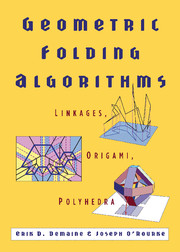Book contents
- Frontmatter
- Contents
- Preface
- 0 Introduction
- Part I Linkages
- Part II Paper
- 10 Introduction
- 11 Foundations
- 12 Simple Crease Patterns
- 13 General Crease Patterns
- 14 Map Folding
- 15 Silhouettes and Gift Wrapping
- 16 The Tree Method
- 17 One Complete Straight Cut
- 18 Flattening Polyhedra
- 19 Geometric Constructibility
- 20 Rigid Origami and Curved Creases
- Part III Polyhedra
- Bibliography
- Index
10 - Introduction
Published online by Cambridge University Press: 07 September 2010
- Frontmatter
- Contents
- Preface
- 0 Introduction
- Part I Linkages
- Part II Paper
- 10 Introduction
- 11 Foundations
- 12 Simple Crease Patterns
- 13 General Crease Patterns
- 14 Map Folding
- 15 Silhouettes and Gift Wrapping
- 16 The Tree Method
- 17 One Complete Straight Cut
- 18 Flattening Polyhedra
- 19 Geometric Constructibility
- 20 Rigid Origami and Curved Creases
- Part III Polyhedra
- Bibliography
- Index
Summary
This second part concerns various forms of paper folding, often called origami. We start in this chapter with a historical background of paper and paper folding (Section 10.1), and of its study from mathematical and computational points of view (Section 10.2). This history can safely be skipped by the uninterested reader. Then in Section 10.3 we define several basic pieces of terminology for describing origami, before providing an overview of Part II in Section 10.4.
HISTORY OF ORIGAMI
The word “origami” comes from Japanese; it is the combination of roots “oru,” which means “fold,” and “kami,” which means “paper.” While origami was originally popularized largely by Japanese culture, its origins are believed to be pre-Japanese, roughly coinciding with the invention of paper itself. Paper, in turn, is believed to have been invented by Ts'ai Lun, a Chinese court official, in 105 a.d. The invention of paper was motivated by the then-recent invention of the camel hair brush, from 250 b.c., which could be used for writing and calligraphy.
Paper, and presumably paper folding at the same time, spread throughout the world over a long period. Buddhist monks spread paper through Korea to Japan in the sixth century a.d. Arabs occupying Samarkand, Uzbekistan, from 751 a.d. brought paper to Egypt in the 900s, and from there continued west. The Moors brought paper (and at the same time, mathematics) to Spain during their invasion in the 700s. In the 1100s, paper making became established in Jativa, Spain.
Information
- Type
- Chapter
- Information
- Geometric Folding AlgorithmsLinkages, Origami, Polyhedra, pp. 167 - 171Publisher: Cambridge University PressPrint publication year: 2007
